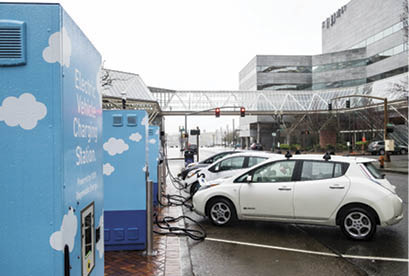Global warming emissions from transportation — the largest sector-based contributor to greenhouse gases in Oregon — are on the rise and show no sign of abating.
A recent greenhouse gas inventory report from the Department of Environmental Quality (DEQ) shows emissions from cars, trucks, aviation and non-road vehicles have risen 15% since 1990.
The number of miles people are traveling in their vehicles has also increased 37% since 1990.
Despite policies to reduce transportation GHGs, such as the promotion of electric vehicles and efficient land use, it is the only sector where emissions rose in Oregon between 2014 and 2016, the DEQ report shows. GHGs from agriculture, industry, electricity, natural gas and residential and commercial sources were all down over the same period.
The transportation emissions trajectory does not bode well for the state’s GHG reduction goal to cut emissions 10% below where they were in 1990 by 2020, and by at least 75% below 1990 levels by 2050.
Cutting global warming gases from this sector is critical because it accounts for the largest share of the state’s emissions – 36% of Oregon’s sector-based GHGs in 2015.
RELATED STORY: DEQ REPORT SHOWS BIG JUMP IN OREGON GREENHOUSE GAS EMISSIONS
Is the state losing momentum on reducing emissions from its biggest source?
Here is a look at the two main areas of Oregon’s transportation emissions reduction efforts – cleans fuels and electric mobility – to see how much progress has been made:
The Clean Fuels Program
Reducing the carbon content in transportation fuels is a critical part of the state’s GHG reduction goals.
The drop in oil prices has made the transition to low emission fuels more pressing. “With the depression in oil prices truck and SUV sales have jumped in Oregon. We really need to have lower carbon fuels,” says Jana Gastellum, climate program manager at the Oregon Environmental Council.
After several years in the making, the legislature passed a bill in 2015 allowing DEQ to start the Clean Fuels Program, an initiative that aims to reduce the average carbon intensity of fuels 10% from 2015 levels by 2025.
The market-based system is designed to incentivize oil companies and other fuel providers to deliver cleaner fuels, such as ethanol, biodiesel and electricity, to market. Producers and importers can either blend ethanol or biodiesel into the fuels they sell to lower the carbon content, or buy credits to meet their carbon intensity reduction targets.
RELATED STORY: ELEPHANTS IN THE ROOM
Providers of clean fuels can register with the program to generate credits that can be sold to those companies that have to comply with the program.
The Clean Fuels Program reduced almost one million tonnes of greenhouse gases in 2017, according to the DEQ. The initiative had little impact on the price of gas, which went up 0.23 cents per gallon in 2017 as a result of the policy; the price of diesel went up 0.31 cents.
“The program is working as intended,” says Colin McConnaha, climate policy manager at the DEQ. One of the yardsticks he uses to measure success is that the market has sufficient credits available to companies to meet the standard’s requirements. The program has generated a surplus of credits since it began.
The initiative has also attracted a good number of companies that can make money from generating credits to sell to companies that need them for compliance.
RELATED STORY: CREDIT PROGRAM COULD REVITALIZE CLEAN FUELS SECTOR, LOCAL DISTRICTS
More than 30 providers of clean fuels have registered. These include several rural public utility districts that can generate credits from providing electricity for charging electric vehicles.
But is the program stringent enough to make an impact on the state meeting its GHG reduction goals?
In its statewide transportation strategy, the Oregon Department of Transportation (ODOT) set out a vision in 2012 for reducing emissions from transportation 60% by 2015. The agency calculated at the time that a clean fuels program would need to achieve a 20% reduction in the carbon intensity of fuels to achieve its target. This is double the goal set out in the current legislation.
In a recent April update to its strategy, ODOT said that while the Clean Fuels Program has proven beneficial by reducing emissions, the agency “assumed a continuous and more aggressive Clean Fuels Program in the future.”
Environmental regulators in Oregon’s southern neighbor, California, which has its own clean fuels standard, the Low Carbon Fuel Standard, have proposed extending their program to 2030, and doubling the emissions reduction target from 10% in average carbon intensity reduction by 2020 to a 20% reduction in 2030.
In Oregon, the political will to make the program more stringent seems far off. Opposition from fuel providers stalled its adoption for several years, and it could be an uphill struggle to convince lawmakers it needs to be more aggressive.
McConnaha says he does not envision the tweaking of Oregon’s Clean Fuels Program anytime soon.
“If the legislature wants to pursue an aggressive strategy, it will be several years away,” he says.
Electric vehicles
The Low Emission Vehicle program was the one of the first actions Oregon took towards its goal of reducing GHGs. It requires auto makers to deliver for sale in Oregon a certain portion of zero emission vehicles and plug-in hybrids. It is also set up to be a kind of market-based system where manufacturers can generate credits from delivering low emissions vehicles to market.
Car makers can use these credits to comply with the regulation. Manufacturers that have a surplus of credits may transfer credits to other regulated companies.
As of June 2016, almost 16,000 electric vehicles and hybrids were registered in Oregon.
RELATED STORY: POWER LANE
But for the regulation to be effective, consumers need to buy electric vehicles; and so far, success has been limited. Electric vehicles represented only about 2% of car sales in Oregon in 2016.
Cost is a big factor. The sticker price of electric vehicles is higher than for cars that run on gasoline. But over the life of the car, electric vehicles can be more cost effective because they are cheaper to operate.
The trouble is, people don’t tend to buy cars based on the total cost of ownership, says Jeff Allen, executive director of Forth, an advocacy group for electric mobility.

The high price of EVs is coming down, however. Costs are predicted to drop as the number of types of vehicles grows. There are now almost 40 electric vehicle models to choose from. Increasingly, electric cars are on the market that you can lease for as little as $200 a month, says Allen.
The single most important policy the state has adopted to encourage EV ownership is a recently introduced rebate program that provides consumers up to $2,500 towards the purchase or lease of a new or used electric vehicle.
The rebates are funded through a tax on auto dealers applied to any new car sold from the beginning of 2018. $12 million annually is dedicated to the program.
“It is a big deal. We expect it drive a lot of sales,” says Allen.
The rebates have worked well in encouraging adoption in other countries. For example, Norway’s incentives for buying electric vehicles increased sales from less than 2% of new car sales to more than 50% in six years.
The rebate program has hit a snag, however. AAA Oregon/Idaho and the Oregon Trucking Associations have filed a lawsuit challenging the funding. They claim the tax revenues used to fund the rebates must be used to improve or maintain public highways as stipulated in Oregon’s constitution and not for non-highway purposes.
The case is before the Oregon Supreme Court.
Another obstacle to EV ownership is the lack of electric vehicle charging infrastructure. It is hard to make money from operating charging stations because electricity is cheap and there are not enough cars using charging stations to make a profit.
RELATED STORY: IN A FRAGMENTED EV CHARGING MARKET, VEHICLE OWNERS STRUGGLE TO FUEL UP
“A lot needs to be done to make charging stations profitable,” says Allen.
Amanda Pietz, program implementation manager at ODOT, says the agency is researching transportation corridors which could benefit from more charging stations. But she adds funding is restricted for the build-out of infrastructure. The agency is searching for partnerships with the private sector for expanding charging stations.
Reducing emissions from transportation is perhaps the biggest GHG reduction challenge facing cities and states today. Allen predicts it will be a lot harder for the state to deal with transportation emissions compared with reducing carbon from the electricity sector, which is, by its nature, more commoditized.
“Transportation is different. It is more personal, emotional and visible in people’s lives,” says Allen. “Policymakers are just beginning to appreciate that. We are with transportation where we were with electricity generation 20 years ago.”
To subscribe to Oregon Business click here.








